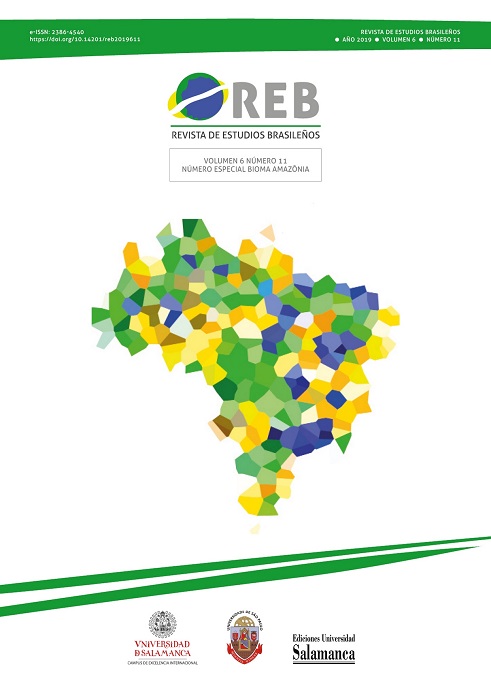Vol. 6 No. 11 (2019): Special Issue Bioma Amazônia e seus desafios
The Revista de Estudios Brasileños from the University of Salamanca, in the 800 years of the institution, publishes, in January 2019, a dossier on the Amazon and its challenges. The publication will bring together eleven essays, an interview with scientist Thomas Lovejoy, and four reviews focused on reference works in the environmental literature. This publication emphasizes, in its contents, the transcontinental relevance of the large biome. There is a meeting of respected specialists on its pages, echoing a discourse based on rigorous metrics and not on proselytizing that permeated the rhetoric of environmentalism.What will be read is a public class taught by people who have made the Amazon the basic goal of their research and life projects. The organizers of the work recommend to the government of the eight Amazonian countries a shared management, which takes into account the alert issued by two citizens of the world, one of them interviewed in the dossier, and the other, a Brazilian, the eminent researcher Carlos Nobre: if deforestation in the region exceeds 20% of the original vegetation, the Amazon will simply cease to be forest.The biome is in a limit situation in its capacity to recycle the water resources, through the evaporation and transpiration of the trees and their organic molecules. This process, important in the condensation of rain clouds, occurs in periods of water shortage in various areas of our continent. The Amazon, so to speak, "exports" the moisture produced in the forest. We speak, therefore, of a region notoriously solidary in environmental matters, which always sharpens the scientists’ interest and power of observation.In the dossier Bioma Amazônia e seus desafios there is a good show of what is done and of what can still be done in the region under analysis. Any approach on environmental governance, forest preservation or land reclamation will necessarily have to give centrality to the role of the Amazon, which is taken as a single biome, although geographically located in eight countries. This means that addressing their challenges in the context of climate change requires a convergent strategy of national states that share their immense biodiversity, gigantic carbon stocks, ecosystem benefits and the inherent risks of their size.The best guide to these combined actions is the content of the Nationally Determined Contributions (NDAs) signed into the Global Climate Agreement and the goals of Agenda 2030 grouped under 17 Sustainable Development Objectives. Full compliance with the goals set forth in these documents will represent, before the world, an unquestionable certificate of good environmental management in the Amazonian countries.The Amazon is one of the areas most studied by experts around the world. It represents the planet's environmental security and can host remarkable experiences with biotechnology. For the reasons outlined in this dossier, it is the most symbolic region of the Green Economy - which can be the most beneficial and fruitful revolution of our time.
Published:
2019-01-24
Presentation
Articles
Interview
-
Interview with Thomas Lovejoy
187-201
